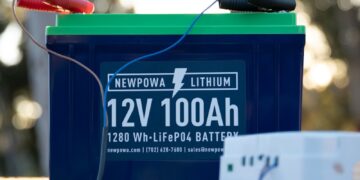As the global energy landscape shifts toward renewables, grid-scale battery storage is emerging as a transformative technology, revolutionizing electricity management and distribution. This rapidly growing sector not only stabilizes the power grid but also offers substantial business opportunities and advances sustainability goals, making it a focal point for investors, policymakers, and environmental advocates.
Market Surge and Growth Projections
The global market for grid-scale battery storage is experiencing unprecedented growth. In 2022, global installations reached approximately 11 gigawatts (GW), a 75% increase from the previous year, bringing the total installed capacity to around 28 GW (IEA Grid-Scale Storage). China led with about 5 GW added, followed closely by the United States with 4 GW. The International Energy Agency (IEA) projects that to achieve net-zero emissions by 2050, grid-scale battery storage must expand 35-fold to nearly 970 GW by 2030, requiring annual additions of about 120 GW from 2023 to 2030.
In the United States, the second quarter of 2024 saw a record deployment of 2,773 megawatts (MW) and 9,982 megawatt-hours (MWh) of grid-scale storage, an 86% increase year over year (ACP Energy Storage Monitor). Projections indicate that total U.S. storage deployments will grow by 42% between 2023 and 2024, with an average annual growth rate of 7.6% from 2025 to 2028. Globally, battery manufacturing capacity is expected to reach 7,900 gigawatt-hours by 2025 (WIRED Battery Storage).
| Region | 2022 Additions (GW) | Total Capacity 2022 (GW) | Projected Growth |
|---|---|---|---|
| Global | 11 | 28 | 970 GW by 2030 (35-fold increase) |
| China | 5 | – | >30 GW by 2025 (excl. pumped-storage) |
| United States | 4 | – | 42% growth 2023-2024, 7.6% annually 2025-2028 |
Economic Viability and Cost Trends
The economic case for grid-scale battery storage is strengthening. Lithium-ion battery costs, which dominate the market, have significantly decreased over the past decade, dropping from $3,000 per kilowatt-hour in 2008 to $150-$200 per kilowatt-hour today. However, 2022 saw a 7% price increase due to rising costs of minerals like lithium, with some relief observed in early 2023 (BloombergNEF Battery Prices). This cost reduction, driven by economies of scale from electric vehicle (EV) manufacturing, has made grid-scale storage increasingly competitive.
The U.S. is also investing heavily in domestic battery production. In 2025, 10 new factories are slated to start, raising total EV battery manufacturing capacity to 421.5 gigawatt-hours per year, reducing reliance on China, which currently produces 80% of global lithium-ion batteries.
Policy Support and Incentives
Government policies are critical drivers of grid-scale battery storage adoption. In the United States, the Inflation Reduction Act of 2022 includes an investment tax credit for stand-alone storage projects, boosting their competitiveness (IEA Grid-Scale Storage). China has set a target to install over 30 GW of energy storage by 2025, excluding pumped-storage hydropower. Other regions are following suit: India aims for 51-84 GW by 2031-32, Australia has funded 2 GW/4.2 GWh of grid-scale batteries, and the European Union has issued recommendations to maximize storage potential.
However, policy uncertainties, such as potential changes to incentives following the 2024 U.S. election, could impact growth. Tariffs on battery imports may also drive domestic manufacturing but could raise costs in the short term.
Business Opportunities
The expansion of grid-scale battery storage presents a wealth of business opportunities across the supply chain. From mining and processing raw materials like lithium, nickel, and cobalt to manufacturing, project development, installation, and maintenance, the sector is ripe for investment. Global investment in battery energy storage exceeded USD 20 billion in 2022 and is projected to surpass USD 35 billion in 2023 (IEA Grid-Scale Storage). Companies like Fluence, a joint venture between AES and Siemens, have deployed 38 gigawatt-hours of storage worldwide, illustrating the market’s scale.
Emerging technologies, such as flow batteries (e.g., the 100 MW, 400 MWh vanadium redox flow battery commissioned in China in 2022), also offer new avenues for innovation. Additionally, repurposing used EV batteries for grid storage could create a circular economy, further expanding business prospects.
| Business Segment | Opportunities |
|---|---|
| Raw Materials | Mining and refining lithium, nickel, cobalt, and graphite |
| Manufacturing | Producing lithium-ion and emerging flow batteries |
| Project Development | Designing and deploying storage facilities |
| Maintenance & Services | Operating and maintaining storage systems |
| Recycling & Second-Life | Repurposing EV batteries for grid applications |
Sustainability and Grid Resilience
Grid-scale battery storage is a linchpin for sustainability. By storing excess energy from renewable sources like solar and wind, batteries enable greater integration of clean energy, reducing reliance on fossil fuel-based peaker plants and lowering greenhouse gas emissions. In Texas, for example, batteries provided record power during 2023 heatwaves, preventing blackouts without requiring reduced consumption (WIRED Battery Storage).
Batteries also enhance grid resilience. They provide rapid frequency response to maintain grid stability, act as reserve power during outages, and support microgrids for remote communities or disaster-prone areas. This resilience is increasingly vital as climate change drives more frequent extreme weather events.
Challenges and Future Outlook
Despite its promise, the grid-scale battery storage sector faces challenges. Current lithium-ion batteries are designed for short-term storage (2-8 hours), but seasonal variations require longer-duration solutions, such as flow batteries or hydrogen storage. Grid interconnection queues, often exceeding three years, delay project deployment. Additionally, rising competition for raw materials and policy uncertainties, such as potential changes to the Inflation Reduction Act, could hinder growth.
Nevertheless, the future is bright. With continued technological advancements, declining costs, and supportive policies, grid-scale battery storage is poised to become a cornerstone of the energy system, potentially accounting for 20-30% of installed power capacity. This transformation will not only facilitate the renewable energy transition but also drive economic growth and innovation in the clean energy sector.
As businesses, governments, and communities collaborate to scale up storage, grid-scale batteries will likely redefine the energy landscape, delivering a more resilient, efficient, and sustainable power grid for generations to come.



















